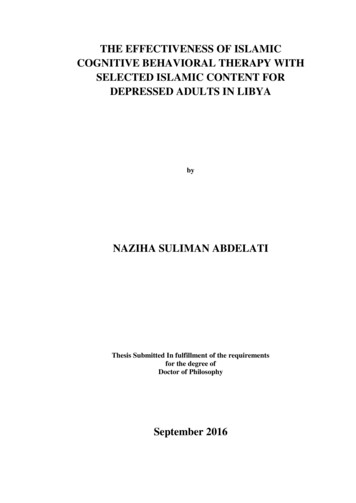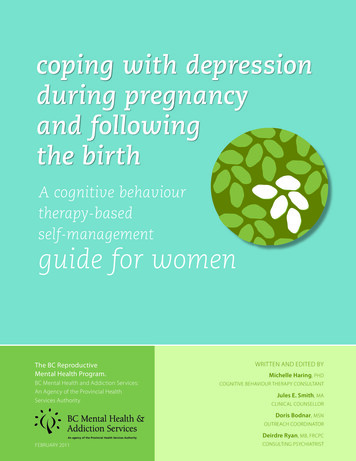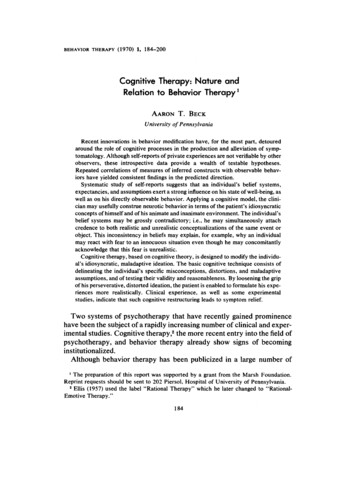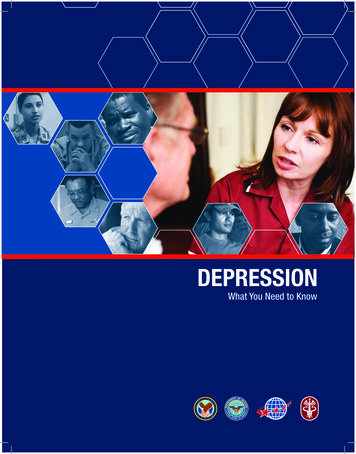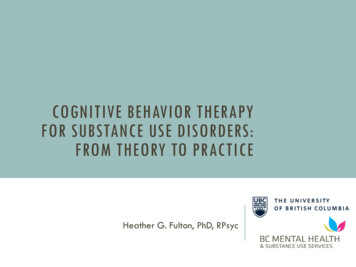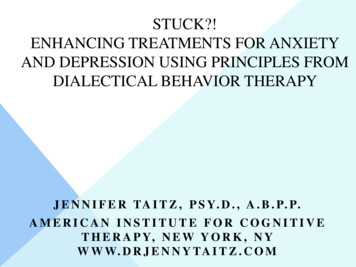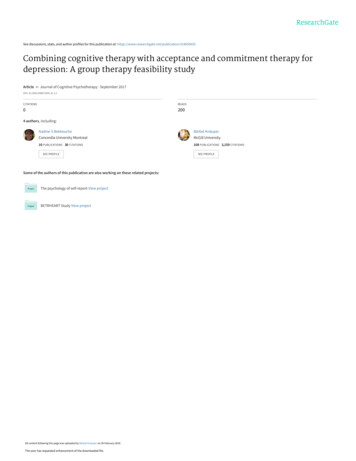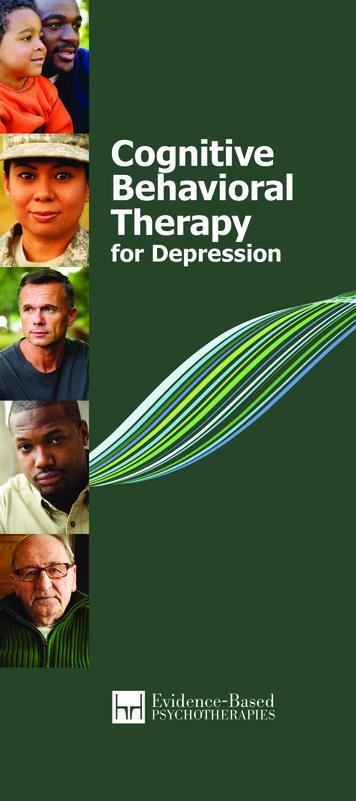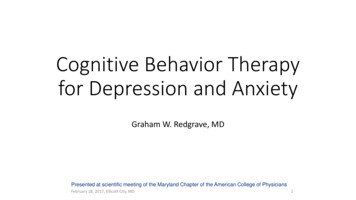
Transcription
Cognitive Behavior Therapyfor Depression and AnxietyGraham W. Redgrave, MDPresented at scientific meeting of the Maryland Chapter of the American College of PhysiciansFebruary 18, 2017, Ellicott City, MD1
Disclosures and Objectives Disclosures: None Objectives:1. Describe the symptoms of major depression and (some) anxiety disorders2. List nonspecific benefits of all psychotherapies3. List the principles of cognitive behavior therapy (CBT)
Overview Clinical assessment of mood and anxiety disorders Psychotherapy in general CBT Indications Overview of approach Resources
Diagnostic challenge of symptoms iac/neuro sx’sSadnessWorryIrritability FatigueInattentionSuicidalityAnxietyRacing thoughtsIncreasedmotor activity
Differential diagnosis and the perspectives ofpsychiatry Major Depression Anxiety disorder Bipolar Disorder Bereavement/grief Adjustment disorder/demoralization Substance abuse disorder Eating disorder Personality disorderWhat a person HASWho a person ISWhat a person DOESWhat a person ENCOUNTERS
Challenges of MDD case definition Major Depressive Disorder is a clinical diagnosis No diagnostic blood test or brain scan Insight needed for optimal self-report Optimal assessment involves skilled clinical assessment andinformation from an outside informant
Major Depression (DSM-5) Five or more of the depressive symptoms present during thesame two week period The symptoms cause clinically significant distress or impairmentin functioning The symptoms are not due to the effects of alcohol or othersubstances or a medical condition (but comorbidity common) Depressive episodes only, no manic, mixed, or hypomanicepisodes Symptoms not better accounted for by bereavement (but not anexclusion)
Epidemiology of Major Depression Lifetime prevalence rates Women 10% – 25% Men5% – 12% Rates equal for pre-pubertal boys and girls Rates in women twice those of men following menarche
Prevalence of Depression in Patients withComorbid Medical IllnessesCardiac DiseaseDiabetes (self-reported)CancerHIV/AIDSChronic PainObesity17-27%26%22-29%5-20%30-54%20-30%Rudisch & Nemeroff 2003; Anderson et al. 2001; Raison & Miller 2003; Cruess et al.2003; Campbell et al. 2003; Stunkard et al. 2003
Prevalence of Major Depression in Patients withNeurologic Disorders Parkinson’s Disease Multiple Sclerosis Migraine Headaches Alzheimer’s disease Amyotrophic Lateral Sclerosis40 – 50 %35 %40 %30 – 50 %no increaseMayeux R, Handbook of Parkinson’s Disease, 1992; Sadovnick et al., Neurology, 1996;Breslau et al., Neurology, 2000; Rabkin, et al., Psychosomatic Medicine 2000; 62:271-9
Suicide and Psychiatric Illness 90% of completed suicides have a diagnosed psychiatric disorder Depressive disorders most common 80% Comorbid Alcohol abuse common Patients with depressive disorders and schizophrenia often commitsuicide early in the course of their illnesses
Suicide risk following hospitalization Increased risk in the period following discharge 33% of depressed patients who commit suicide were hospitalizedwithin the past 6 months Highest risk of a second attempt is in the three months following thefirst attempt
Clinical risk factors for suicide Hopelessness History of prior attempts Lethality of plan and access to means Lack of social supports No established treatment relationship
Protective Factors for suicide Marriage Having dependent children Pregnancy and the first year of the child’s life Religious beliefs Relationships
Initial Assessment Comprehensive history Medical causes of mood symptoms History of previous, milder episodes Assessment for hypomanic, manic and mixed symptoms Mental Status Careful assessment of suicidal thoughts Outside informants Discussion of Diagnosis, Treatment Recommendations, andEmergency Plan
Treatment of Mood Disorders Medications Individual psychotherapy Education and support Family involvement and/or family therapy Control of behaviors (alcohol abuse, substance abuse, eatingdisorders, and cutting) Other treatments Electro-convulsive therapy (ECT) Bright Light Therapy
National Comorbidity Survey Replication (NCS-R) Survey of 9,282 adults Diagnosis of mood, anxiety, and substance abuse disorders Assessment of psychiatric treatment in past 12 months with allproviders Minimally adequate treatment Medication for 2 months 4 visits in a year Psychotherapy: 8 visits (with any provider lasting on average 30 minutes)in a yearWang PS et al. Archives of General Psychiatry 2005;62:629-640
Percent of patients receiving minimallyadequate treatment by provider typeGeneral MedicalPsychiatristPercent with Minimal Tx706050403020100MDDBipolarGADPanicWang PS et al. Archives of General Psychiatry 2005;62:629-640
Course of Recovery fromMajor Depression
Anxiety symptoms Psychic anxiety – mental manifestations of anxiety Worries, fears Somatic anxiety – bodily manifestations of anxiety Palpitations, tachycardia, tachypnea, dyspnea, nausea, diarrhea, etc. Patients may exhibit either or both “Free-floating” or triggered by specific stimuli
(Some) Anxiety Disorders – DSM5 Separation Anxiety Disorder Social Anxiety Disorder Generalized Anxiety Disorder Specific Phobia Panic Disorder Agoraphobia Selective Mutism
Psychotherapy – nonspecific ingredients Occurs in the “assumptive world” The problem: demoralization or loss of hope All psychotherapies consist of: RelationshipSettingRationaleProcedure Individual psychotherapies are evocative or directive (e.g., CBT)Frank & Frank, Persuasion and Healing, 3ed.
Which of these are psychotherapy? Yearly checkup Acute visit for knee pain Writing a prescription for an antihypertensive Discussing loss of a spouse with your doctor
When to use psychotherapy Incomplete response to medication Patient is reluctant to use medications Medication regimen is complex and drug-drug interactions may betoo problematic Failure to respond to medication trials When the patient is not too ill (CBT requires some energy/motivation;safety first!)
Evidence base for CBT Mild-moderate MDD Comorbid MDD and substance abuse Comorbid MDD and PTSD OCD Eating disorders Insomnia Pediatric migraine
CBT – the general idea Learned, automatic thoughtsdevelop over a lifetime Unhelpful thoughts causedistress or drive unhealthybehaviors Learning to ”unthink and undo”these unhealthy thoughts andbehaviors helps patients feelbetter
CBT – the general idea Patients are taught to identify sequences of Situations- AutomaticThoughts- Reactions (feelings, behaviors, physiological reactions) Thoughts are examined and beliefs challenged until they are not heldas strongly Homework is key
CBT – outline of treatment sessions1. Role induction, education about CBT, goal setting, homework2. Check on mood, bridge from previous session, set the agenda,review homework, discuss agenda items, set new homework3.
CBT – identifying cognitive distortions All or nothing thinking Catastrophizing Disqualifying the positive Emotional reasoning Labeling Magnifying/minimizing Selective abstraction Mind reading Overgeneralization Personalization “Should” and “must” Tunnel vision
Resources
Conclusions Mood and anxiety disorders are common, treatable diseases Psychotherapy builds hope Like much in psychiatry, we know that it works but not how it works CBT can be an effective treatment for mood and anxiety disorders Acknowledgements to Karen Swartz, MD!
List the principles of cognitive behavior therapy (CBT) Overview Clinical assessment of mood and anxiety disorders Psychotherapy in general CBT Indications Overview of approach Resources . Diagnostic challenge of symptoms vs syndromes Depression Mania Anxiety Irritability Shame GI/cardiac/neuro sx's
